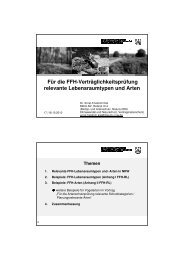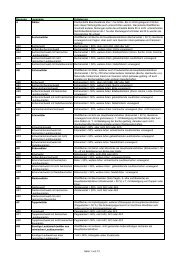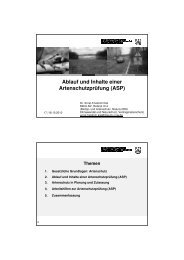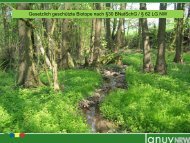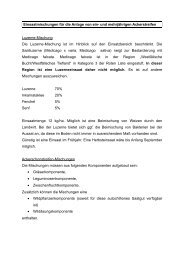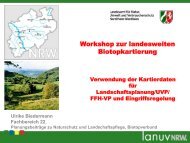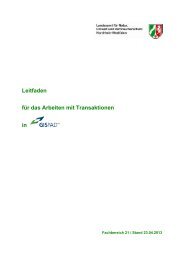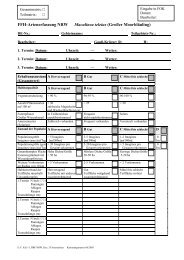Erläuterungen zum Biotop- und Lebensraumtypenkatalog
Erläuterungen zum Biotop- und Lebensraumtypenkatalog
Erläuterungen zum Biotop- und Lebensraumtypenkatalog
Erfolgreiche ePaper selbst erstellen
Machen Sie aus Ihren PDF Publikationen ein blätterbares Flipbook mit unserer einzigartigen Google optimierten e-Paper Software.
<strong>Biotop</strong>- <strong>und</strong> <strong>Lebensraumtypenkatalog</strong> NRW<br />
Code:<br />
Bezeichnung:<br />
4030 Zwergstrauchheiden = §30/62<br />
Verhältnis <strong>zum</strong> B<strong>und</strong>esnaturschutzgesetz § 30 Gesetzlich geschützte <strong>Biotop</strong>e:<br />
ist eingeschlossen in 3. offene Binnendünen, offene natürliche Block-, Schutt- <strong>und</strong> Geröllhalden, Lehm- <strong>und</strong><br />
Lösswände, Zwergstrauch-, Ginster- <strong>und</strong> Wacholderheiden, Borstgrasrasen, Trockenrasen, Schwermetallrasen,<br />
Wälder <strong>und</strong> Gebüsche trockenwarmer Standorte,<br />
Rechtsverbindliche Bezeichnungen:<br />
(Fauna-Flora-Habitat) Richtlinie2006/105/EG DES RATES vom 20. November 2006: 4030 Trockene<br />
europäische Heiden<br />
Relevante Definitionen:<br />
Interpretation Manual EU27: 4030 European dry heaths PAL.CLASS.: 31.2<br />
1) Mesophile or xerophile heaths on siliceous, podsolic soils in moist Atlantic and sub-Atlantic climates of plains<br />
and low mountains of Western, Central and Northern Europe.<br />
Sub-types:<br />
31.21 - Sub-montane Vaccinium-Calluna heaths. Calluno-Genistion pilosae p.(Vaccinion vitisidaeae p.):Vaccinio<br />
myrtilli-Callunetum s.l. i.a. Heaths rich in Vaccinium spp., usually with Calluna vulgaris, of the northern and<br />
western British Isles, the Hercynian ranges and the lower levels of the Alps, the Carpathians, the Pyrenees and<br />
the Cordillera Cantabrica. Interpretation Manual - EUR27 Page 49<br />
31.22 - Sub-Atlantic Calluna-Genista heaths. Calluno-Genistion pilosae p. Low Calluna heaths often rich in<br />
Genista, mostly of the Germano-Baltic lowlands. Similar formations occurring in British upland areas, montane<br />
zones of high mountains of the western Mediterranean basin and high rainfall Adriatic influenced areas are most<br />
conveniently listed here.<br />
31.23 - Atlantic Erica-Ulex heaths. Ulicenion minoris; Daboecenion cantabricae p.; Ulicion maritimae p. Heaths<br />
rich in gorse (Ulex) of the Atlantic margins.<br />
31.24 - Ibero-Atlantic Erica-Ulex-Cistus heaths. Daboecenion cantabricae p.; Ericenion umbellatae p., Ericenion<br />
aragonensis; Ulicion maritimae p.; Genistion micrantho-anglicae p. Aquitanian heaths with rock-roses. Iberian<br />
heaths with numerous species of heathers (notably Erica umbellata, E. aragonensis) and brooms, rock-roses and<br />
often Daboecia. When the rockroses and other Mediterranean shrubs become dominant they should be classified<br />
<strong>und</strong>er sclerophyllous scrubs (32).<br />
31.25 - Boreo-Atlantic Erica cinerea heaths.<br />
2) Plants: 31.21 - Vaccinium spp., Calluna vulgaris; 31.22 - Calluna vulgaris, Genista anglica, G. germanica, G.<br />
pilosa, accompanied by Empetrum nigrum or Vaccinium spp.; 31.23 – Ulex maritimus, U. gallii, Erica cinerea, E.<br />
mackaiana, E. vagans; 31.24 - Erica umbellata, E. aragonensis, E. cinerea, E. andevalensis, Cistus salvifolius,<br />
Calluna vulgaris; 31.25 – Erica cinerea.<br />
3) Corresponding categories<br />
United Kingdom classification: "H1 Calluna vulgaris-Festuca ovina heath", "H2 Calluna vulgaris-Ulex minor<br />
heath", "H3 Ulex minor-Agrostis curtisii heath", "H4 Ulex gallii-Agrostis curtisii heath", "H7 Calluna vulgaris-Scilla<br />
verna heath", "H8 Calluna vulgaris-Ulex gallii heath", "H9 Calluna vulgaris-Deschampsia flexuosa heath", "H10<br />
Calluna vulgaris-Erica cinerea heath", "H12 Calluna vulgaris-Vaccinium myrtillus heaths", "H16 Calluna vulgaris-<br />
Arctostaphylos uva-ursi heath", " H18 Vaccinium myrtillus- Deschampsia flexuosa heath" and "H21 Calluna<br />
vulgaris- Vaccinium myrtillus-Sphagnum capillifolium heath".<br />
Nordic classification : "5111 Rhacomitrium lanuginosum-Empetrum hermaphroditum-typ", "5113 Calluna vulgaris-<br />
Empetrum nigrum-Vaccinium vitis-idea-typ", "5115 Calluna vulgaristyp", "5116 Vaccinium myrtillus- Calluna<br />
vulgaris-typ", "5117 Calluna vulgaris-Hieracium pilosella-typ", "5131 Deschampsia flexuosa-Galium saxatile-typ",<br />
"5132 Agrostis capillaris-Galium saxatile-typ".<br />
Definition für NRW (gilt im Zusammenhang mit den u.st definitorischen Rubriken):<br />
Baumarme oder -freie, typischerweise von Ericaceen (>=30% Deckung) beherrschte, frische bis trockene<br />
Zwergstrauchheiden vom küstenfernen Flachland bis in die Mittelgebirge auf silikatischem bzw. oberflächlich<br />
entkalktem Untergr<strong>und</strong>. Dazu gehören Calluna-Heiden des Flachlandes, deren Krähenbeer- <strong>und</strong> Blaubeerreiche<br />
Ausbildungen sowie die Bergheiden der höheren Lagen.<br />
Lineare Ausbildungen an Sek<strong>und</strong>ärstandorten wie Weganrissen, Böschungen etc. gehören nicht <strong>zum</strong> LRT. Die<br />
Zwergstraucharten decken mindestens 30 % der Fläche, mindestens 1 der diagnostisch relevanten Pflanzenarten<br />
muss frequent vorhanden sein.<br />
Der Flächenanteil der Gehölze, Brache- <strong>und</strong> Störzeiger darf insgesamt maximal 70 % betragen.<br />
Standörtliche Angaben:<br />
Schlüsselfaktoren für das Vorkommen von Trockenen Heiden des Binnenlandes sind vor allem die durch den<br />
Boden vorgegebenen schlechten Nährstoff-, Basen- <strong>und</strong> Wasserhaushaltsverhältnisse.<br />
Trockenheiden des Flachlandes: Standort des Lebensraumtyps sind glazial-fluviatile Sandböden. Meist handelt<br />
es sich hierbei um Podsol, seltener Plaggenesch. Unter jahrh<strong>und</strong>ertelang als Heiden genutzten Flächen sind z.T.<br />
40






